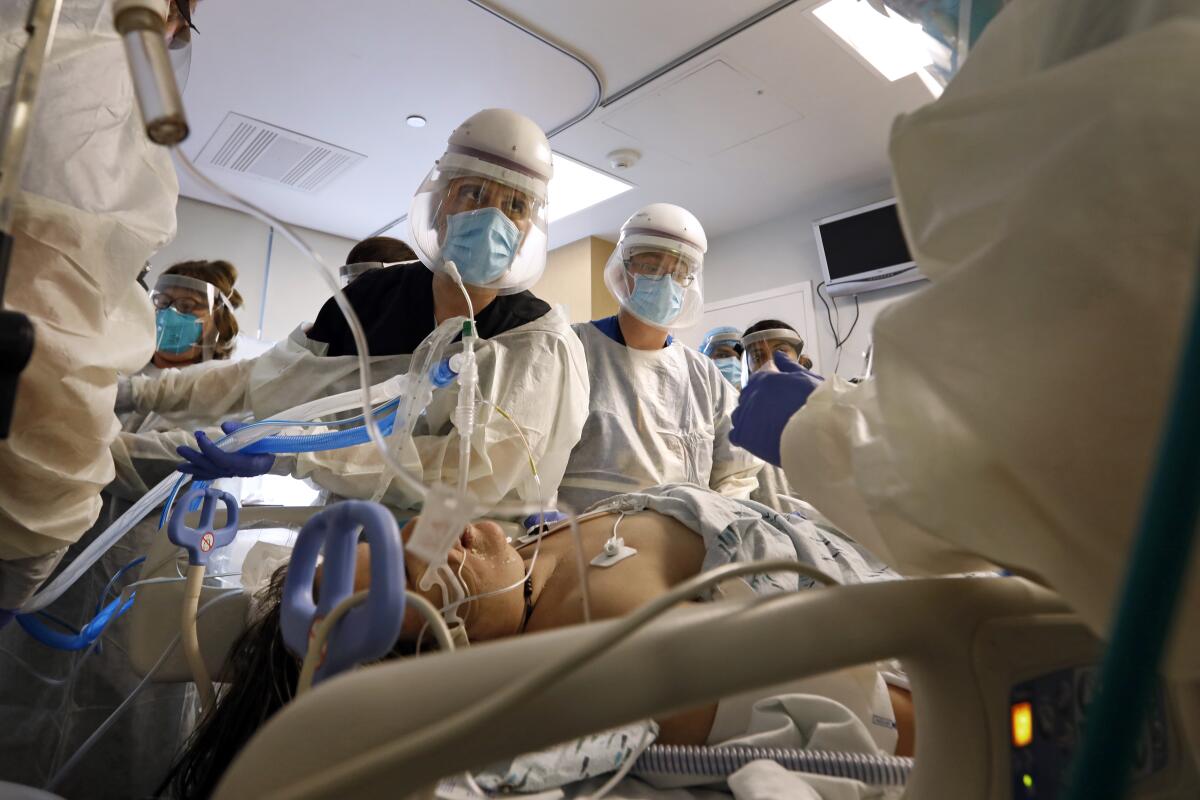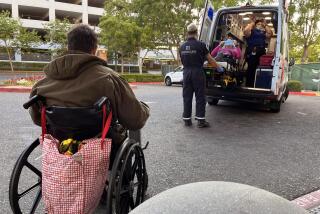Hospitals teeter on edge of ‘last-resort’ guidelines for care

COVID-19 is continuing to put immense strain on healthcare systems throughout California, pushing some hospitals perilously close to a tipping point where officials may have to decide which patients should receive scarce resources, and which shouldn’t.
This bleak outcome, referred to as crisis care, has yet to occur and is “a last-resort environment,” according to Carmela Coyle, president and chief executive of the California Hospital Assn.
The risk is real, however — particularly in hard-hit Southern California and the San Joaquin Valley — and Coyle said Thursday that all hands were on deck to try to stave off that eventuality.
“Hospitals are stretching every opportunity they have, every resource they have, every inch of space they have,” she said during a conference call.
A ‘tragic, upsetting and frankly overwhelming’ situation unfolds as COVID-19 deaths soar in L.A. County.
Crisis care guidelines go into effect when a hospital lacks the staff and resources to care for all patients in the way it normally would.
In those instances, triage teams would be tasked with making the call on who should receive lifesaving treatment.
Those teams would consider “objective criteria only to make the decision about who is most likely to benefit and who is most likely to survive to discharge — and those folks are the ones who will receive treatment,” according to Christopher Meyers, director emeritus of the Kegley Institute of Ethics at Cal State Bakersfield.
The focus, officials said, would be making determinations that are rooted in the best medical science, so that everyone is treated equitably.
“It’s the best way to achieve, we believe, those goals of justice and to make sure that as many people as possible receive the best treatment possible,” Meyers said. “We’re still very much hoping we don’t have to go there. It’s not a done deal.”
Some hospitals have already had to go to extreme lengths to accommodate the crush of COVID-19 patients — such as setting up beds in hallways or gift shops and temporarily treating people in ambulances when there’s no space for them in overcrowded emergency departments. Patients, however, are still receiving professional care and attention, albeit in an unusual way.
“Crisis care is the step beyond that, when there’s just not enough to go around,” said Carol Bayley, former vice president of philosophy and director of justice education for Dignity Health.
Coronavirus has had the 172-bed medical center in various levels of “internal disaster status” since March
A move to crisis care, which officials said had yet to happen in California, would not, of course, be irreversible.
“It’s really determined,” Coyle said, “by the conditions being experienced by that hospital, the demand for the type of care that’s needed in that hospital and the supply of resources in that hospital that are available at that moment.”
Although some state-level officials have expressed cautious optimism that the number of people hospitalized with COVID-19 has leveled off somewhat, healthcare officials have said it’s unclear how enduring that plateau will be or how long it will be before the figure starts declining markedly.
A little more than 21,000 coronavirus-positive patients were hospitalized statewide as of Wednesday, with 4,770 of them in intensive care. Both numbers have remained relatively flat over the past week or so.
Experts, however, remain concerned that the stream of new COVID-19 patients will continue for an extended period — keeping the demand uncomfortably and unsustainably high for overworked hospital staff.
Every day, on average, more than 40,000 additional Californians test positive for the coronavirus. Given that officials estimate roughly 12% of those infected will require hospital care at some point, that means each day’s count includes about 4,800 future COVID-19 patients.
“The problem, of course, is that those numbers are already cooked. They’re already done. The viral spread has already occurred,” Coyle said. “And we in the healthcare delivery system can’t change those numbers of positive infections. All we can do is be prepared to catch those who are now in need of acute care.”
Another surge in cases — perhaps fueled by travel and gatherings over the recent winter holidays — “would be absolutely devastating to our hospitals,” said Dr. Christina Ghaly, L.A. County’s director of health services.
“For there to be any meaningful relief for healthcare providers, we need a swift and significant decline in hospitalizations for a period of one to two months at a minimum,” she said during a briefing Wednesday.
More than 2.8 million Californians have been confirmed as infected throughout the course of the pandemic, and more than 31,600 have died from COVID-19.
Health experts decry the chaotic rollout of the vaccine, but government says progress is on the way.
The COVID-19 pandemic isn’t striking all parts of the state equally. Although hospitals remain under siege in Southern California and the San Joaquin Valley, the state this week lifted the stay-at-home order for Greater Sacramento — as projections indicate the region’s availability of critical ICU beds will improve in the weeks ahead.
Such regional variations are not unexpected in a state as populous and geographically large as California, Coyle said. She added, though, that residents throughout the state should continue to take precautions — such as wearing masks in public and keeping physical distance from those they don’t live with — to protect themselves from becoming infected.
Tightening the transmission tap, officials say, is the only surefire way to provide desperately needed relief to hospitals and stave off the heart-wrenching decisions that would accompany a move to crisis care.
“If we were able to reduce the demand somehow and/or increase the resources, then we wouldn’t even be talking about this,” Meyers said. “At this stage in the game, we’re not going to be increasing resources anytime soon. The fact that we’re not in the crisis level of care at this stage speaks tremendously to the really awesome, amazing work hospitals are doing to stretch their resources. But, as one administrator recently told me, just a tiny bit more pressure and we’ll be across that threshold.”
More to Read
Start your day right
Sign up for Essential California for news, features and recommendations from the L.A. Times and beyond in your inbox six days a week.
You may occasionally receive promotional content from the Los Angeles Times.











